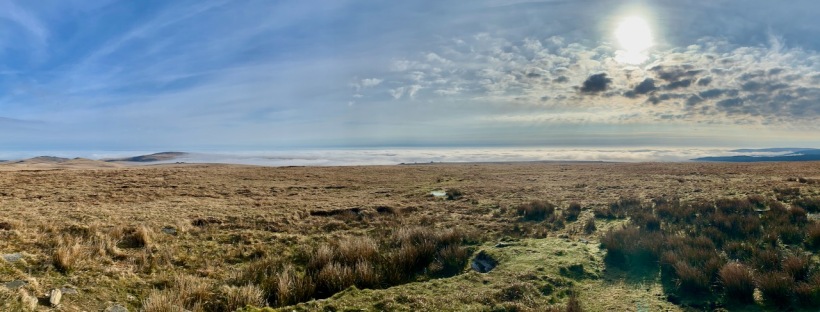
There is an inherent tousle between the solid and the indistinct on the moor. I’m never entirely sure what will be underfoot with my next step, where the faint trail I follow will branch out and meander, diffuse into fescue and bent. This is a landscape of profound slipperiness — path into grass and bog, sodden soil coalescing into pool and rill and stream. Although the River Dart takes its name from the oaks along its lower banks, here at nearly 550 metres, there are no trees for miles, and other than the last year’s grasses still bowed across the incipient stream, the only shadows cast across the flow are my own.
This ebb and flow of unknowing in the steeping of soil and stone in mire and bog and stream are at once frustrating to my forward progress across the moor while also beguiling in its gathering and release of water in this permeable ground.
Solid and steadfast definitions elude me here — much as the word Dart itself is uncertainly constellated from a distillation of Brythonic-rooted Cornish and Welsh. I’ve written before about the derivation of Dart from the Cornish word derow and, similarly, the Welsh derw, most likely after the ancient oaks that overspread the lower reaches of the river after the east and west branches of the river come together at Dartmeet. At the same time, the Proto-Brythonic duβr pauses in downstream eddies of Cornish dowr, Welsh dwr and Breton dour to mean ‘water.’
The blending of water and oak in this the briefest of words has come to define an entire region held together by the waters of the 75 kilometre River Dart from its headwaters high on Dartmoor through Dartmeet, Dartington and Dartmouth (the latter having made its way across the Atlantic and up another river to give its name to a college on its banks in New Hampshire not far from my family’s recent home in Vermont).
I like to imagine, as well, that a third vestigial etymological tributary has made its way into the river’s dominant flow. The Welsh word darlith, meaning ‘lecture’ is derived from the beautiful confluence of dar- and llith, where dar- means widely, outspread or abroad (other derived words include darlledu – to broadcast, spread or broaden; darganfod – to discover; and darlun – a picture or drawing). This wonderful enfolding of proto-Celtic dy– (together) and ar– (near) is a deeply resonant complement to the river’s origins on the moor where water rises to spread widely across the landscape while wending its way through deepening valleys to the weir at Totnes where it blends further with the ocean tides before entering the English Channel at its mouth.
The sculptor Barbara Hepworth, who certainly visited moorland reaches whilst in residence in Cornwall and whose children attended the Dartington School in the 1940s — and without a doubt swam in the river that bounds the estate on three sides — wrote in 1970 as she travelled across the open landscape, ‘Above all, there was the sensation of moving physically over the contours of fulness and concavities, through hollows and over peaks — feeling, touching, seeing, through mind and hand and eye. This sensation has never left me. I, the sculptor, am the landscape. I am the form and I am the hollow, the thrust and the contour.’
I return to the moor time and again and although I am of course drawn to the tors that punctuate the undulating hills, among my most beloved spots are those far from any well-travelled trail where indistinct paths of sheep and horses momentarily gather and then just as soon disperse toward the most tender tufts of grass.
I often find myself in valleys like those of the upper Teign, Tavy, Taw, Okement or Dart moving across a landscape soaked with rain and mist seeking meaning in my own permeability — in the rarest of moments becoming, as Hepworth felt, the form and the hollow, the contour of the hill itself as it slides into the stream and downward toward the sea.


